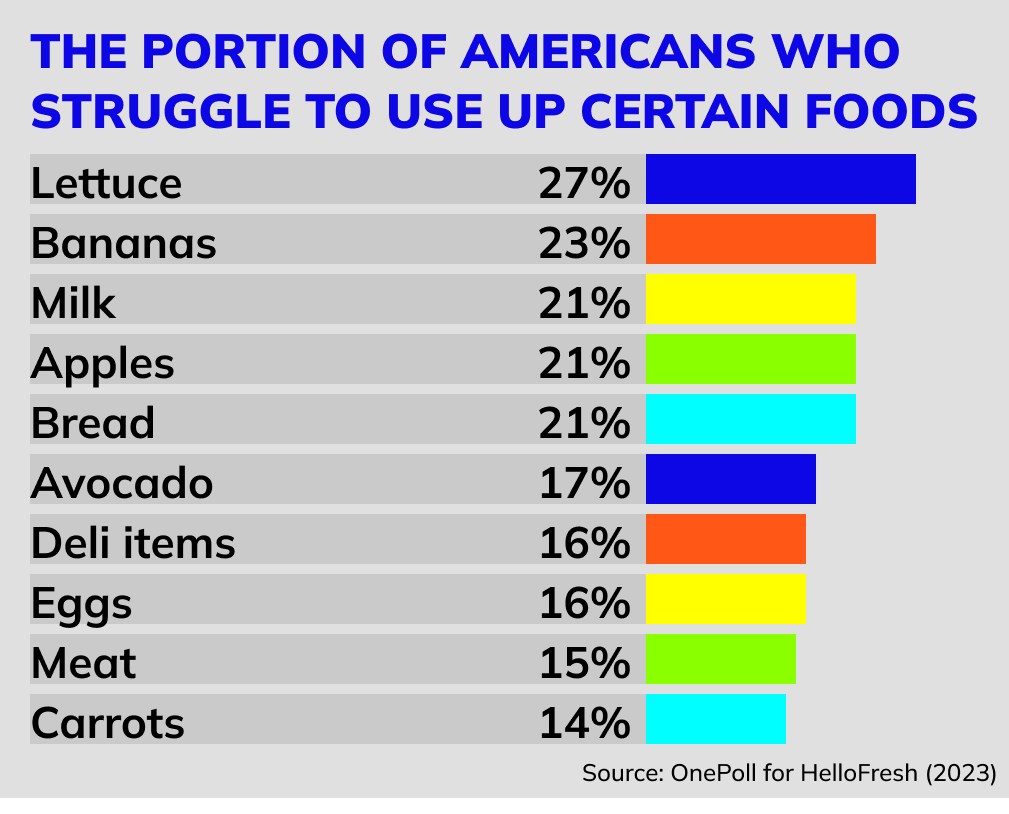For many food lovers, restaurants are the place to splurge. But a lack of restraint and the kitchen’s desire to accommodate it can lead to a lot of wasted food. That means restaurants wind up a notable contributor to the food waste problem, and therefore the climate crisis.
How much food do restaurants waste?
While restaurants and other food service providers waste a lot less food than American households, the amount is still consequential. According to ReFED, a national food waste–focused nonprofit, American homes chucked 42.8 million pounds of grub in 2022. By comparison, American restaurants and food service providers wasted 13 million tons of food that year, or around 14.6% of all of America’s food waste.1
How much does food waste cost restaurants?
The U.S. Department of Agriculture estimates that restaurants across the country lose $162 billion a year on wasted food. That’s around $100,000 of wasted expenses for every $1 million spent, according to a 2017 study in the British Food Journal.2
What causes food waste in restaurants?
The vast majority of restaurant food waste—roughly 70%—comes from what’s left on customers’ plates, according to ReFED.3 Because of foodborne illness and contamination concerns, little of what gets left on the table can legally be repurposed for another meal. That means the untouched bread basket isn’t getting sent to the next table once you leave, nor are any sides you forgot to say no to. The Food and Drug Administration does have some exceptions for unopened but packaged food (like crackers) or dispensable products that have low contamination risk, like ketchup and wine bottles.
The balance of food-service waste comes from overproduction, concerns with date labels, unused byproducts, food spoilage, as well as flubbed cooking, equipment, or handling—like a cook forgetting to wash their hands after touching raw meat.
“Food portion sizes in the United States have increased since the 1970s. Restaurants use larger portion sizes as selling points to suggest to customers that customers are receiving a bargain.”
David blum, sustainability & finance expert
Some restaurants also cause more waste than others. Take the classic buffet model: make many different types of food—and a lot of it—to satisfy literally anyone who might walk in the door, all while regularly refreshing the stations so each tray remains appetizing. That makes buffets exceedingly less sustainable than other restaurant models, according to research done by the University of California, Berkeley.4 “This is because [the buffet model] is difficult for restaurants to match supply and demand, and it is better to oversupply than undersupply, as the latter would lead to exasperated customers,” the authors wrote. “Nearly half of the food at buffets is wasted.”
How can restaurants reduce their food waste?
Some causes of food waste are hard to control, even with the right planning. There’s any number of reasons someone may not want to finish what’s on their plate—maybe they ordered too much, or maybe a stray hair has made their meal unappetizing. While a restaurant may want to reduce waste, it can be hard for managers to figure out how to change their cooking and preparation processes to do so.5 Nonetheless, restaurants can keep a few strategies in mind to reduce waste.
Reduce portion sizes
Oversized portions are a huge problem. “Food portion sizes in the United States have increased since the 1970s,” notes David Blum, an academic who focuses on sustainability, management, and finance. “Restaurants use larger portion sizes as selling points to suggest to customers that customers are receiving a bargain for the food purchase.”
The problem persists outside of America, too. A 2023 survey from the Waste and Resources Action Programme focused on U.K. citizens found that 48% of people point to portion size as the main reason they leave food when eating out. On average, almost 15% of main courses end up uneaten.6
To that end, allowing customized portion sizes can help customers eat what they want without wasting what they can’t physically eat—a practice that isn’t exceptionally widespread in the U.S., despite the popularity of tapas-style dining and the half portions offered at some spots
Conduct a food waste audit and set targets
Analyzing and writing down what goes to waste is the best way restaurant managers can see where the uneaten food is piling up. For example they might notice that demand for some ingredients or dishes is low or waning. Once they see trends, they might revisit the menu to eliminate less ordered dishes, introduce a range of different portion sizes, or decide to let customers split meals. An audit can also help identify which ingredients are getting lost due to failures in safety and storage.
Sign up for compost and donation services
Restaurants should strive to minimize the amount of grub they toss, but when food is on the verge of being wasted, there are ways to minimize the environmental impact. Restaurant owners and managers can teach out to local food kitchens to see how you can donate extra food. They might also also consider some newer solutions. For example, apps like Too Good To Go help divert food from the landfill by connecting people looking for discounted food with restaurants looking to get rid of what’s left at the end of the shift.
If those options don’t pan out, establishments can sign up for a compost subscription or help with a community or backyard pile. In doing so, restaurateurs can eliminate the methane emissions and instead create a useful, soil-like substrate for the garden.
How can I reduce food waste as a restaurant-goer?
Knowing the truth about food waste at restaurants is hard to swallow, but the problem isn’t inevitable. While you can’t go to the kitchen, there’s plenty you can do from the table.
Ask more questions
Don’t feel uncomfortable asking about portion sizes or what else will show up with your main dish. The more likely your plate arrives as you want it, the less likely you’ll find yourself pushing around an undesired side of broccolini until the check comes.
Be honest with what you want
It’s easy to feel obligated to order another appetizer or ask for the dessert menu when the rest of your table is doing so. Yet doing so opens you up to potentially not eating what is in front of you—leading to both food and financial waste.
Share plates
If your table is on the same page about what or how much they want to eat, consider splitting your dishes and sharing. This strategy works especially well at restaurants where you can incrementally order and eat the dishes—tapas style. That way, the group can order based on full they are—or aren’t—as the meal goes on.
Incorporate leftovers into your weekly meal plan—or give them to a friend
Check your calendar before you hit the grocery store. If you know you’re going out to restaurants a few times, figure out where your leftovers might fill in the blanks. If you don’t end up with anything to take home (yay!), then just plan to dip into the pantry or eat something a little sooner than planned. If you do have leftovers but know you won’t get around to them, ask if anyone else wants them. They might have a better shot at being eaten at someone else’s house.
Ask if you can use your own container for take-out
Taking home leftovers can help reduce food waste—assuming you actually eat it. But the problem with leftovers isn’t just strong potential for wasted food and related emissions. A lot of the single-use packaging used to take home leftovers is made of plastic, which carries its own environmental baggage. Instead, try to plan ahead and bring your own reusable containers from home.
Why is reducing food waste so important?
Once wasted food or scraps are chucked in the garbage, they decompose and generate methane, contributing to the climate crisis.
In fact, the amount of wasted food sent to our landfills creates enough methane to rival the amount of carbon dioxide emissions spewed by 42 coal-fired power plants. To that end, local government officials from around the country recently implored federal environment officials to help reduce emissions and end the landfilling of food waste and scraps by 2040.
Food scraps also contribute to the nation’s landfill capacity problem. The U.S. is quickly running out of space to throw out its trash. According to the National Renewable Energy Laboratory, many landfills are running close to capacity and a significant number are scheduled to close by 2050.7
Plus, no matter if you’re throwing out a bowl of cereal or a cheeseburger with all the fixings, you’re also wasting all the resources needed to grow,harvest, and distribute those ingredients. That additional layer of waste is immense; More than 140 million acres of land, nearly 6 trillion gallons of fresh water, enough electricity to power 50 million American homes, and 14 billion pounds of fertilizer are used on wasted food each year.8
What are the most wasted foods in the U.S.?
In April 2023, meal kit company HelloFresh released the results of a commissioned survey on U.S. food purchasing and waste habits. Their poll of 2,000 Americans showed some patterns, but nonetheless highlighted that there isn’t a single type of product that is overwhelmingly wasted more than others.9
Wasted lettuce and bananas were top of mind for respondents, who noted they were the hardest ingredients or food items to use up. But milk, apples, and bread weren’t far behind, nor were avocados, a notoriously fickle fruit to store until use.

- ReFED Insights Engine, Nov. 2023 ↩︎
- Material Flow Cost Accounting for Food Waste in the Restaurant Industry, British Food Journal, Mar. 2017 ↩︎
- ReFED Insights Engine, Nov. 2023 ↩︎
- The Unsustainability of Buffet Food Waste, Global Research and Consulting at Berkeley, 2024 ↩︎
- Ways to Reduce Restaurant Industry Food Waste Costs, International Journal of Applied Management & Technology, 2020 ↩︎
- Portion size is the main reason for plate waste when we eat out, The Waste and Resources Action Programme, Feb. 2023 ↩︎
- Food Waste Disposal and Utilization in the United States: A Spatial Cost Benefit Analysis, Journal of Cleaner Production, Sep. 2021 ↩︎
- From Farm to Kitchen: The Environmental Impacts of U.S. Food Waste, U.S. Environmental Protection Agency, Office of Research and Development, Nov. 2021 ↩︎
- Nearly 1 in 3 Forget About Leftovers Once They’re Out of Sight, SWNS Digital, Apr. 2023 ↩︎

